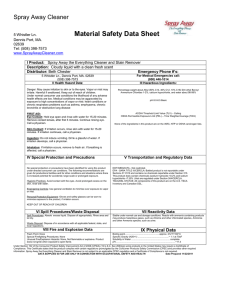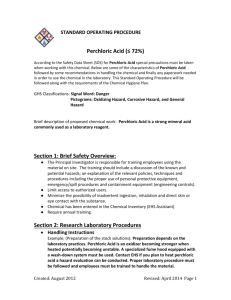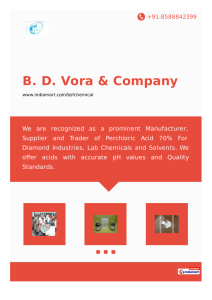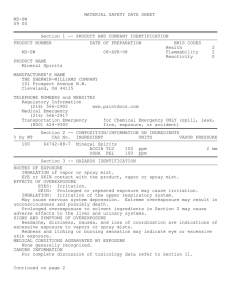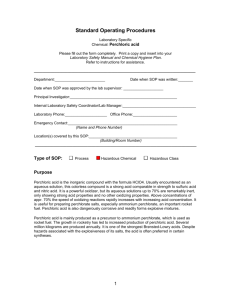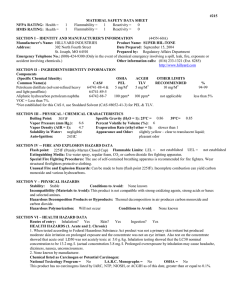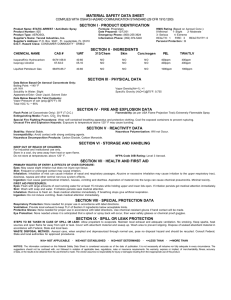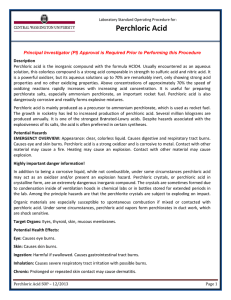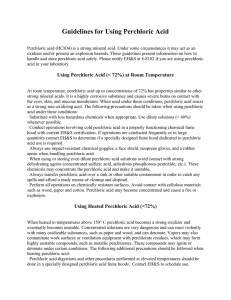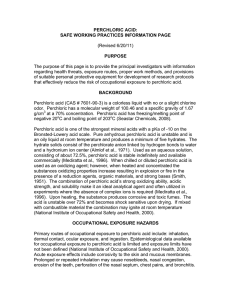PERCHLORIC ACID H
advertisement
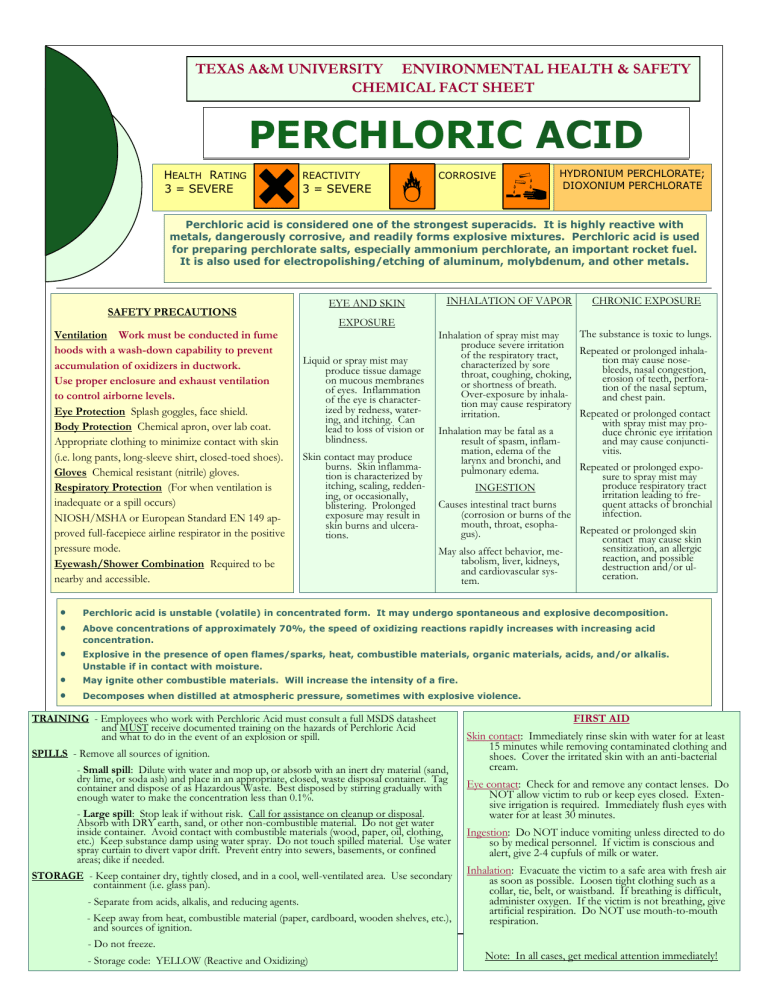
TEXAS A&M UNIVERSITY ENVIRONMENTAL HEALTH & SAFETY CHEMICAL FACT SHEET PERCHLORIC ACID HEALTH RATING 3 = SEVERE REACTIVITY CORROSIVE 3 = SEVERE HYDRONIUM PERCHLORATE; DIOXONIUM PERCHLORATE Perchloric acid is considered one of the strongest superacids. It is highly reactive with metals, dangerously corrosive, and readily forms explosive mixtures. Perchloric acid is used for preparing perchlorate salts, especially ammonium perchlorate, an important rocket fuel. It is also used for electropolishing/etching of aluminum, molybdenum, and other metals. EYE AND SKIN SAFETY PRECAUTIONS Ventilation Work must be conducted in fume hoods with a wash-down capability to prevent accumulation of oxidizers in ductwork. Use proper enclosure and exhaust ventilation to control airborne levels. Eye Protection Splash goggles, face shield. Body Protection Chemical apron, over lab coat. Appropriate clothing to minimize contact with skin (i.e. long pants, long-sleeve shirt, closed-toed shoes). Gloves Chemical resistant (nitrile) gloves. Respiratory Protection (For when ventilation is inadequate or a spill occurs) NIOSH/MSHA or European Standard EN 149 approved full-facepiece airline respirator in the positive pressure mode. Eyewash/Shower Combination Required to be nearby and accessible. EXPOSURE Liquid or spray mist may produce tissue damage on mucous membranes of eyes. Inflammation of the eye is characterized by redness, watering, and itching. Can lead to loss of vision or blindness. Skin contact may produce burns. Skin inflammation is characterized by itching, scaling, reddening, or occasionally, blistering. Prolonged exposure may result in skin burns and ulcerations. INHALATION OF VAPOR CHRONIC EXPOSURE The substance is toxic to lungs. Inhalation of spray mist may produce severe irritation Repeated or prolonged inhalaof the respiratory tract, tion may cause nosecharacterized by sore bleeds, nasal congestion, throat, coughing, choking, erosion of teeth, perforaor shortness of breath. tion of the nasal septum, Over-exposure by inhalaand chest pain. tion may cause respiratory Repeated or prolonged contact irritation. with spray mist may proInhalation may be fatal as a duce chronic eye irritation result of spasm, inflamand may cause conjunctivitis. mation, edema of the larynx and bronchi, and Repeated or prolonged expopulmonary edema. sure to spray mist may produce respiratory tract INGESTION irritation leading to frequent attacks of bronchial Causes intestinal tract burns infection. (corrosion or burns of the mouth, throat, esophaRepeated or prolonged skin gus). contact may cause skin sensitization, an allergic May also affect behavior, mereaction, and possible tabolism, liver, kidneys, destruction and/or uland cardiovascular sysceration. tem. Perchloric acid is unstable (volatile) in concentrated form. It may undergo spontaneous and explosive decomposition. Explosive in the presence of open flames/sparks, heat, combustible materials, organic materials, acids, and/or alkalis. Unstable if in contact with moisture. Above concentrations of approximately 70%, the speed of oxidizing reactions rapidly increases with increasing acid concentration. May ignite other combustible materials. Will increase the intensity of a fire. Decomposes when distilled at atmospheric pressure, sometimes with explosive violence. TRAINING - Employees who work with Perchloric Acid must consult a full MSDS datasheet and MUST receive documented training on the hazards of Perchloric Acid and what to do in the event of an explosion or spill. SPILLS - Remove all sources of ignition. - Small spill: Dilute with water and mop up, or absorb with an inert dry material (sand, dry lime, or soda ash) and place in an appropriate, closed, waste disposal container. Tag container and dispose of as Hazardous Waste. Best disposed by stirring gradually with enough water to make the concentration less than 0.1%. - Large spill: Stop leak if without risk. Call for assistance on cleanup or disposal. Absorb with DRY earth, sand, or other non-combustible material. Do not get water inside container. Avoid contact with combustible materials (wood, paper, oil, clothing, etc.) Keep substance damp using water spray. Do not touch spilled material. Use water spray curtain to divert vapor drift. Prevent entry into sewers, basements, or confined areas; dike if needed. STORAGE - Keep container dry, tightly closed, and in a cool, well-ventilated area. Use secondary containment (i.e. glass pan). - Separate from acids, alkalis, and reducing agents. - Keep away from heat, combustible material (paper, cardboard, wooden shelves, etc.), and sources of ignition. - Do not freeze. - Storage code: YELLOW (Reactive and Oxidizing) FIRST AID Skin contact: Immediately rinse skin with water for at least 15 minutes while removing contaminated clothing and shoes. Cover the irritated skin with an anti-bacterial cream. Eye contact: Check for and remove any contact lenses. Do NOT allow victim to rub or keep eyes closed. Extensive irrigation is required. Immediately flush eyes with water for at least 30 minutes. Ingestion: Do NOT induce vomiting unless directed to do so by medical personnel. If victim is conscious and alert, give 2-4 cupfuls of milk or water. Inhalation: Evacuate the victim to a safe area with fresh air as soon as possible. Loosen tight clothing such as a collar, tie, belt, or waistband. If breathing is difficult, administer oxygen. If the victim is not breathing, give artificial respiration. Do NOT use mouth-to-mouth respiration. Note: In all cases, get medical attention immediately!
